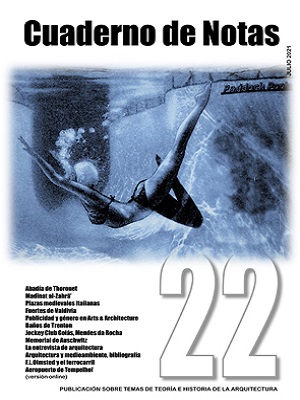Proyectos para un paisaje de la memoria : el Concurso para el Memorial de Auschwitz-Birkenau = Projects for a landscape of memory: The Auschwitz-Birkenau Memorial Competition
DOI:
https://doi.org/10.20868/cn.2021.4752Palabras clave:
Memorial Auschwit-, Birkenau, Paisaje de la memoria, Oskar Hansen, The Road, Forma Abierta, Auschwitz-Birkenau Memorial, Landscape of memory, Open FormResumen
Resumen
El concurso para el Memorial de Auschwitz-Birkeanu, iniciado en 1957, representa un hito en la reflexión sobre el sentido de un paisaje arquitectónico de la memoria en la segunda mitad del siglo XX. Los proyectos que se presentaron en las diferentes fases del concurso, que se alargó diez años hasta 1967, contienen no solo una fuerte carga formal sino una importante búsqueda conceptual por reflejar y sintetizar de manera simbólica, mediante elementos arquitectónicos y de paisaje, la huella de todo el horror que se había vivido en el campo de exterminio polaco. De entre todos ellos destaca el proyecto “The Road”, del equipo dirigido por el arquitecto Oskar Hansen, una propuesta que, de haberse realizado, hubiese marcado un sentido nuevo en el proyecto de paisajes arquitectónicos en su relación con los movimientos plásticos de vanguardia. Sin embargo, el resultado final del concurso fue la construcción de un mero monumento conmemorativo de escaso carácter, perdiendo así una gran oportunidad en la investigación y el desarrollo de los paisajes arquitectónicos contemporáneos.
Abstract
The competition for the Auschwitz-Birkenau Memorial, started in 1957, represents a milestone in the reflection on the meaning of an architectural landscape of memory in the second half of the 20th century. The projects that were presented in the different phases of the contest, which lasted ten years until 1967, contain not only a strong formal charge but also an important conceptual search to symbolically reflect and synthesize, through architectural and landscape elements, the footprint of all the horror that had been lived in the Polish Death Camp. Among all of them stands out the project “The Road”, developed by the team led by the architect Oskar Hansen, a proposal that, if it had been carried out, would have marked a new meaning in the architectural landscape project in its relationship with avant-garde plastic movements. However, the end result of the competition was the construction of a mere commemorative monument of little character, thus missing a great opportunity in the research and development of contemporary architectural landscapes.
Descargas
Referencias
Bauman, Zygmunt. 2006 (1989). Modernidad y Holocausto. Madrid: Sequitur.
Benton, Charlotte. 2004. Figuration-abstraction: strategies for public sculpture in Europe 1945- 1968. Aldershot: Ashgate.
Evak, Tonia (ed). 2010. Henry Moore and Auschwitz. Catálogo exposición. Varsovia: Adam Mickiewicz.
Hansen, Oskar y Zofia. 1961. The Open Form – The Art of the Great Number. En: Newman, Oscar y Krämer, Karl (eds.). CIAM’59. Stuttgart: Otterlo Verlag. 190-191.
Hansen, Oskar y Zofia. 2005. Towards Open Form. Fundacja Galerii Foksal.
Lafuente, Julio. Concurso Internacional para el Monumento a Auschwitz. Revista Nacional de Arquitectura, 1958, 204: 42-44.
Lafuente, Julio. Concurso para el Monumento Internacional de Auschwitz (Polonia) 1958. Nueva Forma, 1973, 88: 10-13.
Levi, Primo. 2007 (1958). Si esto es un hombre. Barcelona: El Aleph.
Maliszewska, Marta. The Road Monument by Oskar Hansen-Critical Narration and Commemoration Discourse. En: The Polish Journal of Aesthetics, 47(4/2017): 129-142
Molina Iniesta, Mariano. El proyecto de Oskar Hansen para Auschwitz y la monumentalización del debate sobre la guerra. RA, 2019, 14: 123-128.
Murawska-Muthesius, Katarzyna. Oskar Hansen, Henry Moore and the Auschwitz Memorial debates in Poland 1958-59. En: Benton, Charlotte. 2016. Figuration / Abstraction: Strategies for Public Sculpture in Europe 1945-196. Londres y Nueva York: Routledge. 193-211.
Murawska-Muthesius, Katarzyna 2010. ‘His sculpture King and Queen is, for me, unacceptable’. Moore, Hansen and the Auschwitz Counter-Monument. En: Toniak, Eva (ed). Henry Moore and Auschwitz. Catálogo exposición. Varsovia: Adam Mickiewicz.
Pietrasik, Agata. 2010. Traversing Monumentality - Succesive Desings for the Auschwitz Monument. En: EVAK, Tonia (ed). Henry Moore and Auschwitz. Catálogo exposición. Varsovia: Adam Mickiewicz.
Pietrasik, Agata. 2014. Abstraction & Figuration in the Auschwitz Memorial from Consensus to Dissensus’. En: Alexandra Klei, Katrin Stoll y Annika Wienert (eds.). Die Transformation der Lager. Annäherungen an die Orte nationalsozialistischer Verbrechen. Transcript Verlag. 141-154.
Referencia web: Murawska-Muthesius, Katarzyna. 2002. Oskar Hansen and the Auschwitz “Coun-termemorial” 1958-59. https://artmargins. com/oskar-hansen-and-the-auschwitz-qcoun-termemorialq-1958-59/ (visitada 27 de marzo de 2020).
Referencia web: Ruíz Alonso, Jesús J. 2018. Oskar Hansen y la Forma Abierta. Influencias e inte-rrelaciones en al arte contemporáneo. Beca de Investigación sobre Arte contemporáneo. Museo Patio Herreriano de Valladolid. https:// museoph.org/files/2018-10/jesu-s-j-ruiz-alonso-oskar-hansen-y-la-forma-abierta-beca-de-investigacio-n-2018..pdf?776310301c
Simoncini, Giorgio. 2012. La Memoria di Auschwitz. Storia di un monumento 1957-1967. Milán: Jaca Book.
Young, James E. (ed.). 1994. The Art of Memory: Holocaust Memorials in History. Nueva York: Jewish Museum with Prestel-Verlag.
Young, James E. (ed.). 2003. The Texture of Memory. Holocaust Memorials and Meaning. New Haven y Londres: Yale University Press.
Zevi, Bruno. 1967. Il monumento di Auschwitz. Neppure l’urlo di Rodin basterebbe. Cronache di Architettura, vol. VI. Bari: Laterza.













